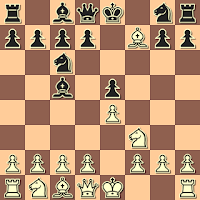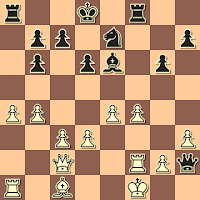Wall, Bill - Guest3967134
PlayChess.com, 2015
1.e4 e5 2.Nf3 Nc6 3.Bc4 Bc5 4.Bxf7+
4...Kxf7 5.Nxe5+ Nxe5 6.d4 Bxd4 7.Qxd4 Qf6
Black has given back one of the sacrificed pieces, and then developed his Queen to where it protects his King, controls the center and threatens an exchange. Surely, this is enough?
8.Qc5
A couple of notable alternatives:
8.Qe3 as in Wall,B - Tsyalex, PlayChess.com, 2015 (1-0, 20); and
8.Qd1 as seen in an unfinished correspondence game Jerome,A - Norton, D.P., 1876, and the later Jerome,A - Jaeger,D, correspondence, 1879, (1-0, 35).
Don't overlook "Why Did He Play That Move?"
8...Qd6 9.Qc3
The positional 9.Qxd6!? was seen in Wall,B - berserkergang, FICS, 2011: 9...cxd6 10. O-O Nf6 11. Nc3 a6 12. Rd1 Ke7 13. b3 b5 14. Ba3 Nf7 15. e5 Ne8 16. exd6+ Nexd6 17. Ne4 Bb7 18. Nxd6 Nxd6 19. Rxd6 Kd8 20. Rad1 Bc6 21.Rxc6 Black resigned
9...Nf6 10.Bf4 Nxe4
Giving back the other sacrificed piece. Surely, this at least draws?
11.Qxe5 Qxe5 12.Bxe5 d6
13.f3 Re8 14.fxe4 Rxe5 15.Nc3 c6
Black has play against White's isolated e-pawn - plus a Bishop for a Knight. Winning in the endgame is no shame.
16.Rf1+ Kg8 17.O-O-O d5 18.exd5 Bd7 19.dxc6 Bxc6
Black has sacrificed a pawn for dynamic piece play. Look at that Bishop!
20.g3 Rae8 21.Rd4 h6 22.Kd2 a6 23.a3 Bb5 24.Nxb5 axb5 25.Rf2 b6
Okay, maybe things are going a bit awry for Black...
26.Rd6 Kh7 27.Rxb6 Rd5+ 28.Kc3 Re3+ 29.Kb4 Re4+ 30.Kb3 Re3+ 31.c3 Rde5 32.Rb7 Re7 33.Rxb5 Re2 34.Rxe2 Rxe2 35.a4
35...Rxh2 36.a5 Rg2 37.a6 Rxg3 38.a7 Black resigned







































